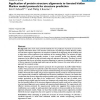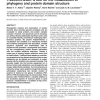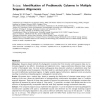820 search results - page 26 / 164 » Using Multiple Alignments to Improve Gene Prediction |
BMCBI
2008
13 years 7 months ago
2008
Background: Mining gene patterns that are common to multiple genomes is an important biological problem, which can lead us to novel biological insights. When family classification...
BMCBI
2006
13 years 7 months ago
2006
Background: Many DNA regulatory elements occur as multiple instances within a target promoter. Gibbs sampling programs for finding DNA regulatory elements de novo can be prohibiti...
BMCBI
2006
13 years 7 months ago
2006
Background: One of the most powerful methods for the prediction of protein structure from sequence information alone is the iterative construction of profile-type models. Because ...
NAR
2006
13 years 7 months ago
2006
Phylogenetic analysis and examination of protein domains allow accurate genome annotation and are invaluable to study proteins and protein complex evolution. However, two sequence...
ALMOB
2008
13 years 7 months ago
2008
Motivation: Sequence-based methods for phylogenetic reconstruction from (nucleic acid) sequence data are notoriously plagued by two effects: homoplasies and alignment errors. Larg...



